Seeya, ’16, you were one helluva year
By: Tim Cynova // Published: December 26, 2016
There are a lot of reasons why people are looking forward to 2016 wrapping up. Bruising Presidential campaign. Loss of cultural icons, including space heroes and artistic geniuses. Multiple E. coli scares at Chipotle. This isn’t a post about any of those things, especially E. coli.
This is a post about a group of individuals who came together as a team and turned 2016 into a banner year. One of those years you look back on and think, damn, that was a great year.
Here’s the synopsis of accomplishments:
Unlimited days off.
Expanded family medical leave.
Objectives and key results.
Total office renovation.
Professional employer organization.
Switched 401k providers.
Senior Professional in HR body of knowledge.
Build a humane, respectful, and trusting hourly pay structure.
Multiple hardware and software changes liberating staff from a fixed work site.
Tools for talking when talking turns tough.
Launched staff anti-racism and anti-oppression training.
Published How We Work: A Guide to Working at Fractured Atlas website.
24 Staffing changes.
I count myself incredibly fortunate to do something that I love, with people I respect and who make me raise my game every day. About a year back, two of my coworkers and I came together to form what inside Fractured Atlas is referred to as our People team. In my role as COO, I have the distinct pleasure of leading this team as we work to provide our smart, talented, hardworking, and inspiring coworkers with what they need to do their best work and thrive. And in doing so, we as an organization can continue to innovate and provide our 60,000+ creative members with the services and support they need to be even awesomer.
The days are long. Lists grow seemingly exponentially. People’s heads dip below the waterline. And time rolls on. This post is taking a quick breather to reflect on the challenges and triumphs we’ve experienced during the past 12–18 months. While the intrepid Fractured Atlas People team — Nicola Carpenter, Jillian Wright, and I— helped spearhead many of these efforts, we neither did it alone or in isolation. Thirty-four Fractured Atlas staff were riding with us the whole time.
[Editor’s Note: This is still me, Tim, the person writing this post. I just wanted to separately emphasize one important point. For the record, not every staff member at Fractured Atlas is thrilled with the things on this list. Some people dislike our transition to unlimited days off. Some people love the new office, others hate it and the process we used. Some people like the recently expanded family medical leave, others think it’s a bad policy. Cultivating an engaged workforce with shared purpose is anything but a neat, tidy, and pain-free process. A few years ago, we adopted a guiding phrase at Fractured Atlas: directionally correct. Essentially, something might not be perfect, but in the spirit of not letting The Perfect be the enemy of The Good, we think that the decision is headed in the right direction. We are far from a perfect company. We have healthy dialogue, unhealthy dialogue, and sometimes the lack of any kind of dialogue. Creating an environment that supports staff and allows people to thrive is part art, part science. This is us on our journey.]
Often times during the job interview process, people ask us what it’s like to work at Fractured Atlas. One common refrain is that we operate in a blazingly fast environment, with constant change, and with a great deal of ambiguity. Not everyone excels in this type of environment. There are incredibly talented people, who are amazing at what they do, who don’t comfortably function in an environment that’s constantly changing. It’s why we’ve structured our interview process to find people who can thrive in that type of workplace.
Below is a little peek at some of the constant change we’ve experienced over the past year. Hopefully there’s something in this list that gives you an idea you can borrow, steal, or iterate on to help build an environment in your own organization that makes it better and more effective tomorrow than it is today. We’re on that same journey and happy to talk more with you about our process. So, in no particular order…
Unlimited days off
We’ve all been there. Rationing our vacation days or bending over backwards to avoid using them so we can “bank them” to cash out when we change jobs. In the meantime, our mental and physical health takes a toll for that future monetary reward, or that big vacation we never end up taking, well, because we have too much to do. Or, we finally take that big vacation and then try to hold on until our days off allotment resets so we can take another much-needed day. What a weird way for us to work, yet it’s the norm.
Why don’t we make clear what employees need to accomplish, work with them to accomplish it, and just let them take whatever days they need to stay healthy, happy, and engaged? Why do we run a tracker when nobody likes tracking? We often build systems for the worst (often fictional) offenders and then force everyone to use it as though they will abuse the system by default unless it’s spelled out in excruciating, rigid detail.
When we were creating our unlimited days off policy, we found two pieces of related research that we continue to share with staff: (1) With unlimited day off policies people actually take fewer days. This isn’t the reason we went the unlimited route, and we repeatedly ask managers to be proactive about making sure staff are taking time off. A burned out staff member is no use to anyone. Related, no one is indispensable. Just as it’s healthy for the employee to take time off, it’s healthy for the organization. It allows the company to identify single points of failure and adjust operations accordingly. (2) In order to get the real benefits of taking time off you need to chunk time into at least two-week periods. And, you need to unplug. Two weeks vacation won’t recharge you if you’re constantly checking email and Flowdock. Give someone your cell number and ask that they text if it’s an absolute emergency. Otherwise, remove your work email account from your phone and trust your coworkers to handle things that come up.
OKRs
Flexibility in where and how one works isn’t successful unless people know that what they’re doing is the right work to be doing. Thus, enter OKRs (or Objectives and Key Results).
For people to know what’s important to the company, identify their priorities, and how it all connects, we needed a system to pull it all together. Judging the quality of your work by how exhausted you are when you leave the office is the wrong ruler to use. Toiling endlessly hoping that what you’re working on is making a difference is risky business. Checking in with your supervisor once a year to make sure that what you’ve been doing is what you should be doing, and done in the way that is most helpful, is likely to be fraught with surprises for both of you.
We rolled out OKRs throughout the organization this past year. Not all at once, but every quarter we added another group to the mix, eventually ending up with all staff members completing quarterly OKR. With OKRs we’re able to tie them directly to taking the time you need to unwind. It’s not about punching a clock, it’s about the work output. It’s also about aligning every staff member’s OKRs from the top down and back up again so we all can see what we’re working on, how it relates to the organization’s success, and then (initially a bit scary since it means everyone can see everyone else’s) how well we did in meeting our goals. If you’re interested, here’s a helpful book about OKRs.
(We benefit immensely from our coworker Ian David Moss “riding herd” on this initiative. Thanks, Ian!)
Expanded Family Medical Leave
Life happens when you’re making plans, or when you least expect it. While we maintain an unlimited day off policy for vacation and sick days, staff requested that we spell out a specific policy for family medical leave. We talked with a lot of People people to create this and settled on a “cradle to grave” approach that covers parental leave (any caregiver), personal health crisis; and caring for parents, spouses, siblings, or children who might have an extended illness. We landed on two months paid and an additional month unpaid leave. While it’s not the 5+ months that Google or Etsy provide new parents, we feel good about it given our size and means, and imagine it places Fractured Atlas in the top 99th percentile of employers providing this length of non-mandated paid leave.

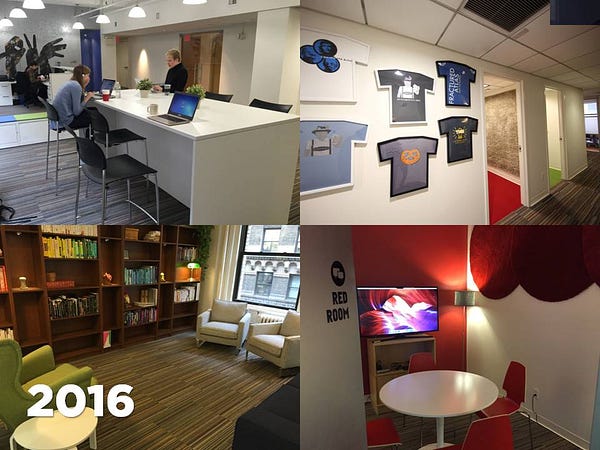
Total office renovation
This item could easily fall under Operations, but when was the last time you completed an office renovation that didn’t impact people? (Lest you disagree, stay tuned for my forthcoming post, “Human Psychology & The Office Renovation.” Check out Harvard Business Review’s take in the meantime.)
We ran out of available desk space in late 2015 and needed a solution. Seeing that moment on the horizon, we started a renovation process that took a little over 18 months — 16 months of planning, prep, and conversations; 2 months to complete — and involved a total rethinking of how people use an office environment in the 21st century versus then, say, in 1986.
For anyone who’s renovated an office before, you know about 25% of the effort is about what it’s going to look like, project managing, ordering, contractors, etc., the remaining 75% is the related staff conversations. The percentages shift even more if the renovation includes eliminating private and semi-private offices (for everyone of us, including the CEO), “unplugging” people from dedicated workspaces in favor of a locker, laptop, and workspace flexibility. Again, like anything we do at Fractured Atlas nothing is ever “finished”. A few months after we moved back into our renovated office we circulated an employee usability survey and began tweaking the new space.
Professional Employer Organization
How many people love their payroll provider? We didn’t. It was the devil we knew for years, but was getting impossible to bear. In 2016 we finally switched services!
In searching for a new payroll provider, we quickly realized that the landscape had changed and if we were going to go through the hassle of changing providers, we had a rare opportunity to level up service. While professional employer organizations have been around for decades, they only recently gained increased prominence with the use of sleek software and a plethora of start-ups wanting to outsource their HR function.
After our long search, we landed with Justworks. Not only did we get a new payroll provider with 21st Century software UI, but we also instantly gained a national insurance network providing our staff working in 10 different states with medical, dental, and vision insurance options that, prior to the switch, had been a slow state-by-state slog. The system now allows each staff member to more easily manage their payroll deductions, insurance-related issues, and requests for time off, all without ever needing to contact a member of the People team. We’re leveraging the Justworks team to supplement our small People staff, freeing up precious time to work on other important things, and in the process creating a more powerful service for each of us.
Switched our 401k providers
That right, watch out world! When we get rolling switching away from sticky vendors, we blow out the cobwebs and keep rolling.
After Jillian and I read Josh Brown’s Backstage Wall Street, we became increasingly convinced that our current 401k was more a vehicle to make money for the provider, and less about giving our employees the knowledge and tools they needed to make smart decisions about how to plan for life.
Like a payroll provider, a 401k provider is extremely sticky. The whole industry is built on inertia, and it’s a huge lift to change. You need to be really pissed and really motivated to change providers, which after countless requests to help our staff were denied, we were both. We felt it was important for staff members to be able to meet one-on-one with a certified Personal Financial Planner. We knew from a staff financial wellness survey that people wanted to eliminate college debt, save to buy a house, and/or prepare to start a family and eventually send those kids to college. We all needed the peace of mind that comes with having a conversation with someone who could help us evaluate our personal risk profile and prioritize where, and how, we saved for the future.
One of the things we learned in spades from this switch is that nothing is ever “5 Easy Steps”. Multiply the steps by ten and then you might be in the ballpark. It was a heavy lift to transition providers, but in the end, we’re all much happier with Ritholtz Wealth Management than with our previous provider. Much happier and much more informed that how we’re saving is in line with where we individually want to go in life.
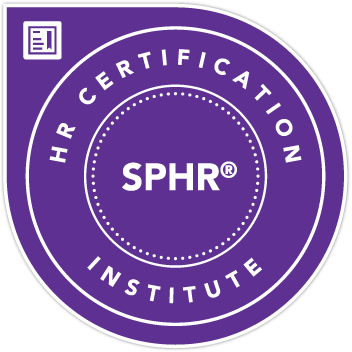
Senior Professional in Human Resources Body of Knowledge
Much of what we do with People ops at Fractured Atlas is variate on a theme. Theme: Vacation days. Variation: Unlimited vacation days. While unlimited days off is cool and all, it’s important to know how and how far we can vary from the theme.
We needed to have a better understanding of the guardrails required by employment law and the related organizational behavior implications. For this reason, we felt it was important that we have more than an HR for Dummies understanding of the various laws and regulations that guide People policies. In the first part of 2016, I studied to take and pass the exam to become a certified Senior Professional in Human Resources (the CPA of HR). In 2017, Jillian will begin studying to pass the PHR or SHRM’s CP version of the exam so we can deepen our bench. And this knowledge didn’t come a moment too soon…
Build a humane, respectful, and trusting hourly pay structure
While the jury is still out on whether the proposed changes to the Fair Labor Standards Act regarding non-exempt levels will be enacted, we decided shortly after the news was released in last Spring that we would move an entire staff tier to hourly, non-exempt (from overtime) regardless. We didn’t want to mess around with people, their roles, and compensation, and then at the eleventh hour pull the carpet out from under them if, as happened, a legal challenge paused the game. We felt it would be disrespectful to our people to leave them in limbo while things that are completely out of our control played out at a speed completely out of our control.
In trying to create a broader hourly structure for Fractured Atlas, we quickly realized that hourly pay systems often result in distrust, antagonistic, and petty squabbles between employers and employees. We’ve spent years building a Fractured Atlas culture that trusts people to do the right thing, gives them the appropriate level of autonomy to get it done, invests in their career development, and all in a “Work Hard. Live Well.” environment. That’s easier when you’re not punching a clock. Far more difficult when you introduce a remote work structure, flexible schedules, and fluidity between teams, all while trying to avoid overtime as the default. Through countless interviews, research, and focus groups, we feel like we landed in a place that creates the basis for an hourly employment structure we can be proud of and that others might want to adopt. It’s certainly not complete— as if anything we work on is final — but we have the outline and trust that together we’ll all invent something we can be proud of.
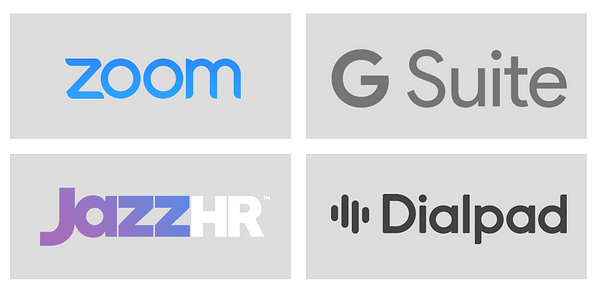
Hardware & Software Changes
Tools change and evolve over time. GeoCities, anyone? A company that knows how to successfully transition from one tool to next, without imploding the ability for people to communicate and complete their work, has a significant edge over one that clings to old, outdated tools that have outlived their usefulness. While the former can be nimble, innovative, and opportunistic, the latter often stagnates.
It just so happened that 2016 was as big year for hardware and software tool transitions at Fractured Atlas. Much of these transitions were driven by our broader How We Work movement, adjusting how people physically work to fit various styles rather than prescribing the exact thing for everyone.
Real Phone to Softphone. The first hurdle to clear when liberating staff from a sedentary styles was eliminating real phones in favor of a “softphone” solution. Softphones (often referred to at VoIP) run through the internet and operate any place staff want to work — the office, their home, a coworking space, an airport or hotel — any place that has an internet connection is now be a phone booth. Previously you needed to be sitting next to your phone at your assigned desk, or dial in to check your messages. (We actually transitioned through two softphones solutions landing first with Twilio and ultimately with Dialpad.)
Desktops to Laptops. The next big necessary change to enable people to have mobility was to give them computers that were mobile. We moved everyone off of old desktop machines and onto MacBooks or Lenovos, depending on their Mac/PC preference and the type of work they did. These two changes really set the staff free. More than 25% of our staff are fully remote across 10 states, with an additional 50% of staff working remotely 1–2 days a week. This doesn’t even include those who travel or are sick but not “sick sick” and decide to work from home rather than risk infecting their coworkers at HQ with the flu.
Video conferencing. With personnel flexibility and fluidity, we use video conferencing software constantly. It’s a rarity for a meeting not to include at least one person on video. It’s sometimes faster and easier to jump on a video call with someone than hash out the thing in an extended email back-on-forth. We originally used Bluejeans but recently switched to Zoom. (#ProTip: Regardless of the software solution you select, always ask if they offer a discount for nonprofit organizations. We’ve found that most companies do even if they don’t publicly list one on their site.)
Email and calendars. A few weeks ago we transitioned away from an email and calendar application called Zimbra — one we’ve used for years — to G Suite (Google’s new name for its Google Apps). When we originally opted for Zimbra, Google’s business-level service wasn’t nearly as robust as it is today. This became one of those platforms that we decided was no longer in our best interest to maintain using our internal software developer resources. With our switch to G Suite, those developer resources can be more effectively deployed building and maintaining cool and helpful things for our membership.
Applicant tracking system. Lastly, for the past few years we’ve been trying to improve the process for people who apply to work at Fractured Atlas. The old email process was inefficient when processing 300+ applications for a job opening, and it didn’t allow us to easily communicate with people who applied. It certainly didn’t live up to the level of customer service we aim to provide. We wanted to find a way to make the process more humane and responsive. While we’re still honing it, we transitioned to an applicant tracking system called Jazz.
(We are incredibly fortunate to work with Shawn Anderson, our Vice President of Engineering, who helped us figure out and deploy many of these options. Thanks, Shawn!)
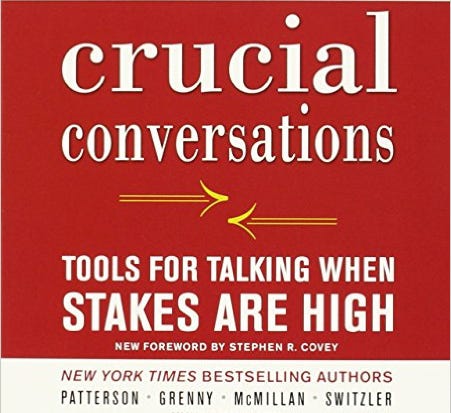
Tools for talking when talking turns tough
Research shows that one of the traits of high performing teams is the ability to engage in healthy conflict. We knew this was an area that we needed to improve. We realized as teams, and as an organization, we weren’t getting better at having healthy conflict in our meetings, we were getting better at avoiding the topics that lead to conflict. We needed tools and a shared vocabulary to help us feel better equipped when the talking turned tough. In researching a framework to use, we uncovered an entire conversational cottage industry.
We looked at Crucial Conversations, Difficult Conversations, and Fierce Conversations. It quickly came down to Crucial and Fierce, ultimately feeling that Crucial Conversations (or CruCon as we affectionately call it) would be a better fit for what the entire staff needed right now; although, referencing a few of the things we really loved from the Fierce framework. Both Crucial and Fierce allowed us to have one staff member initially trained as a certified internal trainer, so we could break up our staff into training groups, and then continue to come back to the training without the added expense of continually hiring an outside facilitator. Has it eliminated unhealthy conflict or the avoidance of conflict? Nope, have you met human beings before? It has improved our willingness and ability to have crucial conversations both at work and beyond.
Launched staff anti-racism and anti-oppression training
Fractured Atlas recently penned a post describing the important anti-racism and anti-oppression work we’ve been doing as staff over the past year. While we’ll be sharing more in the coming months about the process, if you haven’t read that post I invite you to take a few minutes to check it out. From a People ops perspective, this past year has focused us on how our work influences, supports, and sometimes hinders, anti-racism and anti-oppression efforts. It has caused us to examine our personal biases and assumptions to ensure that the work we do isn’t inadvertently or otherwise undermining that work.
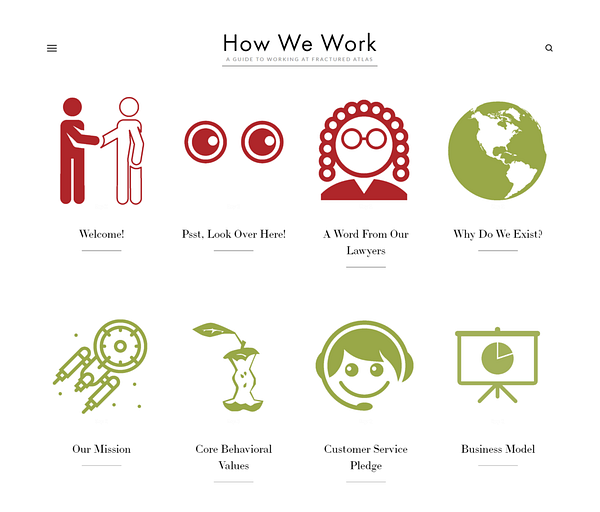
Published How We Work: A Guide to Working at Fractured Atlas
One of the biggest milestones for People ops this year was launching our How We Work website. It was a long time coming, you might say 18 years. It’s a site that captures in one place our philosophy of work and life at Fractured Atlas. The public site serves both as one half of our employee handbook and a creative commons resource for anyone who wants to borrow an idea or two for their own organization. We published it in this way as we believe the openness and transparency help us all. It helps fuel the conversation so we can become stronger organizations and a stronger cultural sector.
Fractured Atlas Staff
Staffing changes
And lastly, we close with a traditional People people item: staffing. We recently tallied that during the past 18 months there have been 24 staffing changes at Fractured Atlas, including four people who moved on to other jobs and two who left for Grad school. (For the record, our average staff tenure at Fractured Atlas is 4.9 years, which I actually think might be trending a bit too long, but I’ll save that for another post.) About 10 were internal staffing changes — promotions, new positions being created, sliding laterally from one team to another, etc. — and the rest were new hires. As anyone in the People space knows, it’s not just hiring and on-boarding that are accompanied by a long list of “actionables.” Off-boarding and “in-boarding” have long lists too. Set-up or shutdown various online accounts, insurance enrollments or COBRA coverage, set-up or scrub laptops, scheduling and conducting Core Curriculum training or farewell parties, and the list goes on. It was only after we tallied the 24 that we realized, oh, that’s why we’ve been so exhausted recently.
Keeping the trains running and on time is no small feat in an environment experiencing constant change. It’s one of those true pleasures though to do it at a place and with a team where it seems less like drudgery and more like you found the winning lottery ticket in your pocket. We’ve learned a great deal this past year and are sitting on a treasure trove of helpful information. Ping us if you have questions.
OK, 2017, let’s dance.
Tim Cynova is a leader, HR consultant, and educator dedicated to co-creating anti-racist and anti-oppressive workplaces through using human-centered organizational design. He is a certified Senior Professional in HR, trained mediator, principal at Work. Shouldn’t. Suck., on faculty at New York’s The New School and Canada’s Banff Centre for Arts and Creativity, and for the past twelve years served as COO and then Co-CEO of the largest association of artists, creatives, and makers in the U.S.

